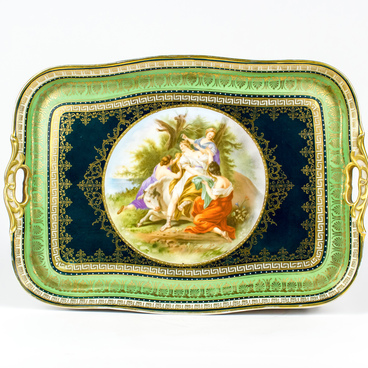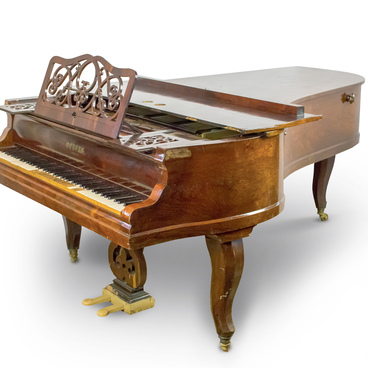The exhibition features an egg serving dish with a lid in the form of a plate with three indentations. It is painted with floral ornaments in a warm color palette. The artist applied red, yellow, and burgundy colors.
The rim of the egg serving dish is decorated with a gilded edging, with large and small semicircles paintings thereunder. The egg serving dish is covered by a lid with an ornately shaped handle. There is an ornament around the handle, separating the lid into four equal parts. A bunch of flowers is depicted on each part.
Until 1917, one Tetyushsky district family had kept the egg serving dish. After the nationaliation of the merchant’s property, the egg serving dish was handed over to the Сity Museum of Local Lore.
The earliest pictures of egg stands date back to the year 3 AD. Archaeologists discovered them on a Turkish mosaic. Moreover, the first samples of such dishware were found among the Pompeii ruins by the researchers, and they dated back to the year 79 AD.
The scientists suppose that initially such egg stands were made of wood, and later on, they began to be made of silver and other metals. At the beginning of the 18th century, aristocrats used silver egg cups with the owner’s emblem engraved on them. They came with special spoons. For the next two centuries, the egg cup remained an integral of the dinner set.
In the 19th century, silver cups with gilding inside replaced the porcelain ones. Gilding was used so that the sulphur in the eggs would not stain the silver. The egg cup spoons could be made of different materials — from silver to ivory.
The egg serving dish on display is made of frosted glass. Glass manufacturing in Russia started during the reign of Mikhail Fedorovich, who granted Elisha Koet, the “cannon caster”, and the Swede in the service of Russia, a land plot near Moscow for the construction of a factory. Under Alexey Mikhailovich and Peter the Great, the glass business gained traction, and on the cusp of the 17th and 18th centuries several factories producing window glass, mirrors, and glassware were operated in Moscow. There were also two glass factories, which Peter the Great placed under the management of Alexander Menshikov in the city of Yamburg recaptured from the Swedes.
The rim of the egg serving dish is decorated with a gilded edging, with large and small semicircles paintings thereunder. The egg serving dish is covered by a lid with an ornately shaped handle. There is an ornament around the handle, separating the lid into four equal parts. A bunch of flowers is depicted on each part.
Until 1917, one Tetyushsky district family had kept the egg serving dish. After the nationaliation of the merchant’s property, the egg serving dish was handed over to the Сity Museum of Local Lore.
The earliest pictures of egg stands date back to the year 3 AD. Archaeologists discovered them on a Turkish mosaic. Moreover, the first samples of such dishware were found among the Pompeii ruins by the researchers, and they dated back to the year 79 AD.
The scientists suppose that initially such egg stands were made of wood, and later on, they began to be made of silver and other metals. At the beginning of the 18th century, aristocrats used silver egg cups with the owner’s emblem engraved on them. They came with special spoons. For the next two centuries, the egg cup remained an integral of the dinner set.
In the 19th century, silver cups with gilding inside replaced the porcelain ones. Gilding was used so that the sulphur in the eggs would not stain the silver. The egg cup spoons could be made of different materials — from silver to ivory.
The egg serving dish on display is made of frosted glass. Glass manufacturing in Russia started during the reign of Mikhail Fedorovich, who granted Elisha Koet, the “cannon caster”, and the Swede in the service of Russia, a land plot near Moscow for the construction of a factory. Under Alexey Mikhailovich and Peter the Great, the glass business gained traction, and on the cusp of the 17th and 18th centuries several factories producing window glass, mirrors, and glassware were operated in Moscow. There were also two glass factories, which Peter the Great placed under the management of Alexander Menshikov in the city of Yamburg recaptured from the Swedes.



